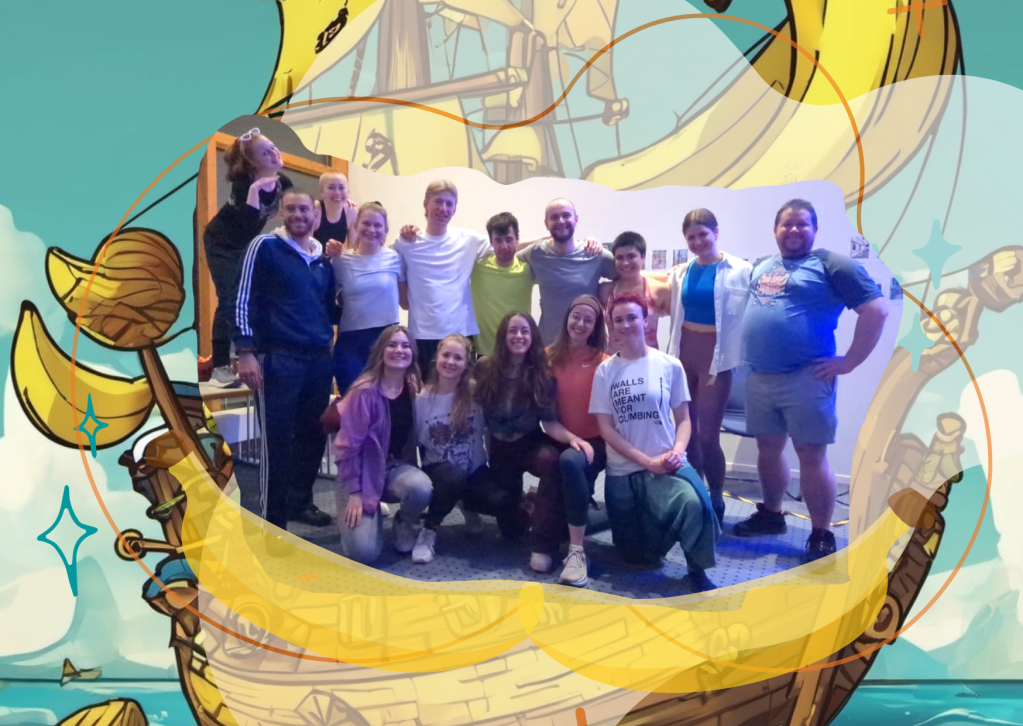As part of my graduate school goals and pursuits has been to gain valuable teaching experience at the college level in order for me to be better prepared for a career in collegiate teaching and academia upon graduating. This has been easier said than done as I’ve overcome various challenges and barriers to achieve the same kind of PhD experience that most of my colleagues are afforded. Without being offered an opportunity to teach a class for the university as part of traditional PhD studies, I have sought out and been proactive in pursuing opportunities to do guest lectures, and workshops for colleges and universities around the world, as well as major sports organizations and conferences. Through these endeavors I have certainly learned a lot and have gained some solid experience.
Back in August/September, a colleague of mine but me up as a recommendation to the Studienstiftung des deutschen Volkes, or German Academic Scholarship Foundation, which is Germany’s highest, most prestigious, and only secular scholarship fund. To the extent that only a small fraction of applicants are accepted every year. My recommendation though wasn’t for a scholarship, it was an invitation to teach for the Studienstiftung! Specifically, to teach as part of a week-long education retreat called the “Spring Academy” which is part of a series of such events the Studiestifung hosts all throughout the year. The Academies are retreats to various parts of Germany, hosted on a campus, and is structured with several different working groups that are taught and led by professionals in academia, industry, and commercial fields. The diversity of topics presented offers students the opportunity to learn from and connect with professionals who share knowledge and experiences about their field for students to learn from as part of their educational journey. Of course, I immediately say yes, this is the kind of experience I am looking for! Even more so, it’s my first opportunity to design a course curriculum that extends over a period of time, so with that I got to work. I knew my audience would be college students representing a wide array of different majors and fields of studies.
Of course, my topic would be on the basic principles of sport/exercise science and sport/exercise psychology, but rather than spending all week lecturing, I took on an approach that incorporated lectures, practical activities on my part as well as student led activities. My goal was for the students to expand their knowledge on the capabilities of exercise and sport to create positive effects physically, mentally, and socially. My teaching approach was based on the foundational drivers of the three basic psycho-social needs. Simply put, my week-long course format was built on ensuring that my students were able to develop a sense of autonomy, competence, and relatedness during their week. Through this foundation, I incorporated practical activities and exercises meant to stimulate the body and mind, activities and games that involved partner work, team work, everybody together to promote team work and build social cohesion. This was intermixed in with the lectures and presentations that can often become a bit tiresome as a result of sitting for extended periods of time.
Furthermore, I tasked the students to select, read, and present on a research paper of their choosing related to our field, doing the same with a practical exercise as well each was tasked to teach to the group. This way, the students were able to select a topic and activity of specific interest to them, related to the field of our course and share it with the group on why they think it’s important and why they enjoy it. In addition, I screened a documentary, “Light in the Water” as part of the evening program for the entire Spring Academy that also connected well with our course.
Keeping things flexible, there was also room to try some new and unexpected things. I made sure that everybody in the course knew I was looking for feedback and that we can adjust things to accommodate as needed, so the students felt comfortable in speaking up and asking to change things around if needed. For example, during my lecture on cardiovascular exercise, I showed a picture of Richard Simmons as an example for someone who has pioneered the field in promoting exercise and health via aerobic exercise. Shockingly, none of the students knew who he was and after taking a few minutes explaining how he was the face of aerobics in the 1980s/1990s, they were asking if I could show them one of his videos. Of course, we just weren’t going to *show* the video since this was a course on exercise and sport, so we put a video on and started doing some classic Richard Simmons’ “Sweatin’ to the Oldies!” In the end, my goal was to make sure all the basic content I laid out would be covered, even if the process in which we learned it took on new (or classic) and unexpected formats! The students each had voice in shaping how their learning experience evolved.
This has an unexpected effect in that the students really enjoyed such a classic, to the extent we did a few more sets throughout the week as they sung along to the music. As the week went on, I observed my students were becoming very motivated and outright enthusiastic about the things we were doing! Even during the lectures, they were attentive and focused, asking amazing questions and engaging in thoughtful discussions. During the lectures I regularly asked the students about their thoughts, observations, reflections, which encouraged everybody to ask questions, share about their own experiences, and even to expand on the topic themselves. Often times I had to slow the students down because we would easily get ahead of ourselves, and I’d have to remind them about spoiler alerts on my next slides.
During their research paper presentations, the student shared research topics all related to super specific elements within the field that were relevant and important to their interests. With such a diversity of different topics presented, they all were able to connect back to the more general subject content of the material I was teaching and made it easy to see how many of these research projects were rooted within the basic principles of sport/exercise science. I noted the same thing during their practical activities as well, with a diversity of different physical activities taught, ranging from things like cheerleading stunts, martial arts drills, Tabata sets, dancer’s movement rituals, Rock n’ Roll Dancing, and so much more. Everybody in class got to try some new things and learn how to move their bodies while overcoming self-imposed mental limitations to challenge themselves. A great example of this was one student being a cheerleading coach and teaching the class how to do some pyramids and cheerleading stunt poses. I’ll admit, I was a bit nervous myself about someone getting hurt, but the student did an amazing job ensuring safety and instruction cues were clear and helping guide the class to do the poses slowly and safely. In the end, everybody in the class (including me) discovered a new capability within themselves that reminded us that our biggest challenges are often the limitations we place upon ourselves.
As we approached the last few days of the week, the Delayed Onset Muscle Soreness (DOMS) from our exercise activities was definitely starting to hit, but despite the moans and groans on those first few squats, everybody was still eager to learn and do more. At one point, a student noted that “the other groups saw some of the exercises and games we were playing and looked a bit jealous.” So, the students proposed doing a kind of “exercise break flash mob” where we would surprise the other working groups, get everybody on their feet and do a fun 2–3-minute exercise to get everybody awake and active. I told them they just need to ensure they have consent from the other lecturers (and ask when would be the best time), but otherwise they were to organize it themselves. The group then selected the “Banana Pirate Dance” and split up into two teams to cover the four other groups (2 per team) and off they went.
Afterwards we reflected on the experience, with the students sharing how much fun and exciting it was! Some were nervous to do it but let their energy carry them through and rolled with it. All four flash mobs went successfully with positive feedback coming from the other lecturers and leaders. I pointed out how their experience planning the exercise, then knocking on the door, going into the room and immediately getting the unexpected (and surprised) people to quickly jump in and do the activity was, in itself, a “performance”. As such, we connected it easily with my lecture on the psychology of performance and arousal regulation, with the flash mob serving as a perfect practical exercise and example on arousal regulation within a performance. It was even better the next day when one of the groups decided to get their revenge and pulled a reverse flash mob on us, with their group storming into our room and getting us up to do a fun “exercise break”. It had such a big impact on the Spring Academy as a whole, with the other groups making memes and everybody joking about it afterwards.
As I tell all my athletes, students, and everybody I work with. Make sure you have a grand entrance and ALWAYS have a big finish.
Earlier in the week, I reminded the students that on Friday evening, each of the groups would get 15 minutes to do some kind of performance presentation on everything we learned throughout the week. I made sure the students knew that this was their job to plan and organize entirely on their own. But of course, I did help a bit. After singing along to Sweatin’ at the Oldies all week, they decided they wanted to lead the entire Spring Academy through one of Richard Simmon’s aerobics routines, and finish it off with a full, Spring Academy size “Banana Pirate Dance”. After all I taught them about the principles of sport/exercise science and psychology, shared experiences in participating in high level competitions, the process of setting goals, building a plan, training hard and putting in the work to see it through, everything that comes before the big event for when it is time to perform. The Friday evening showcase served as another practical experience for what all of that is like, what it *means* to be an athlete and furthermore, what it *means* to be a champion.
Come late Friday evening, our group requested to be the last group to present and after some great performances by the other groups, it was our turn. They came in with a grand entrance, nailed their performance, and sent off our week-long Spring Academy with the biggest finish yet!
In the end, I received overwhelming positive feedback from the students and the organizers. More importantly is that I had several students share with me how their experiences over the week helped inspire them in various ways to build upon the foundation we established and to use it as a launching pad to help others discover the physical, mental, and social benefits of exercise and sport. You can’t ask for anything better than that!



